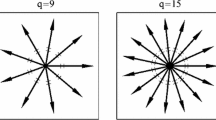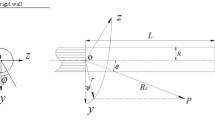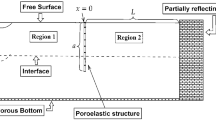Abstract
Ocean boundaries present a significant effect on the vibroacoustic characteristics and sound propagation of an elastic structure in practice. In this study, an efficient finite element/wave superposition method (FE/WSM) for predicting the three-dimensional acoustic radiation from an arbitrary-shaped radiator in Pekeris waveguides with a lossy seabed is proposed. The method is based on the FE method (FEM), WSM, and sound propagation models. First, a near-field vibroacoustic model is established by the FEM to obtain vibration information on a radiator surface. Then, the WSM based on the Helmholtz boundary integral is used to predict the far-field acoustic radiation and propagation. Furthermore, the rigorous image source method and complex normal mode are employed to obtain the near- and far-field Green’s function (GF), respectively. The former, which is based on the spherical wave decomposition, is adopted to accurately solve the near-field source strength, and the far-field acoustic radiation is calculated by the latter and perturbation theory. The simulations of both models are compared to theoretical wavenumber integration solutions. Finally, numerical experiments on elastic spherical and cylindrical shells in Pekeris waveguides are presented to validate the accuracy and efficiency of the proposed method. The results show that the FE/WSM is adaptable to complex radiators and ocean-acoustic environments, and are easy to implement and computationally efficient in calculating the structural vibration, acoustic radiation, and sound propagation of arbitrarily shaped radiators in practical ocean environments.
Similar content being viewed by others
References
Bai, Z. G., Wu, W. W., Zuo, C. K., Zhang, F., and Xiong, C. X., 2014. Sound radiation and spread characteristics of cylindrical shell in finite depth water. Journal of Ship Research, Z1: 178–190 (in Chinese with English abstract).
Ballard, M. S., 2019. Three-dimensional acoustic propagation effects induced by the sea ice canopy. Journal of the Acoustical Society of America, 146(4): EL364–EL368.
Brekhovskikh, L. M., 1980. Waves in Layered Media. 2nd edition. Academic Press, New York, 228–234.
Cockrell, K. L., and Schmidt, H., 2010. A relationship between the waveguide invariant and wavenumber integration. Journal of the Acoustical Society of America, 128(1): EL63–EL68.
Collis, J. M., Frank, S. D., Metzler, A. M., and Preston, K. S., 2016. Elastic parabolic equation and normal mode solutions for seismo-acoustic propagation in underwater environments with ice covers. Journal of the Acoustical Society of America, 139(5): 2672–2682.
Fahnline, J. B., and Koopmann, G. H., 1991. A numerical solution for the general radiation problem based on the combined methods of superposition and singular-value decomposition. Journal of the Acoustical Society of America, 90(5): 2808–2819.
Irena, L., and Henrik, S., 2006. Subcritical scattering from buried elastic shells. Journal of the Acoustical Society of America, 120(6): 3566–3583.
Jensen, F. B., Kuperman, W. A., Porter, M. B., Schmidt, H., and Bartram, J. F., 2011. Computational Ocean Acoustics. Springer, New York, 103–105.
Jiang, L. W., Zou, M. S., Huang, H., and Feng, X. L., 2018. Integrated calculation method of acoustic radiation and propagation for floating bodies in shallow water. Journal of the Acoustical Society of America, 143(5): EL430–EL436.
Jiang, L. W., Zou, M. S., Liu, S. X., and Huang, H., 2020. Calculation method of acoustic radiation for floating bodies in shallow sea considering complex ocean acoustic environments. Journal of Sound and Vibration, 476: 115330.
Junger, M. C., and Feit, D., 1986. Sound, Structures, and Their Interaction. MIT Press, Cambridge, 235–251.
Katsnelson, B., Petnikov, V., and Lynch, J., 2012. Fundamentals of Shallow Water Acoustics. Springer, New York, 79–92.
Klaseboer, E., Sepehrirahnama, S., and Chan, D., 2017. Spacetime domain solutions of the wave equation by a non-singular boundary integral method and Fourier transform. The Journal of the Acoustical Society of America, 142(2): 697–707.
Koopmann, G. H., Song, L., and Fahnline, J., 1989. A method for computing acoustic fields based on the principle of wave superposition. Journal of the Acoustical Society of America, 86(6): 2433–2438.
Liu, R. Y., and Li, Z. L., 2019. Effects of rough surface on sound propagation in shallow water. Chinese Physics B, 28(1): 423–430.
Ma, Z., Cheng, Y., Zhai, G. J., and Ou, J. P., 2015. Hydroelastic analysis of a very large floating structure edged with a pair of submerged horizontal plates. Journal of Ocean University of China, 14: 228–236.
Marburg, S., and Nolte, B., 2008. Computational Acoustics of Noise Propagation in Fluids—Finite and Boundary Element Methods. Springer, Berlin Heidelberg, 24–40.
Miller, R. D., 1991. A comparison between the boundary element method and the wave superposition approach for the analysis of the scattered fields from rigid bodies and elastic shells. Journal of the Acoustical Society of America, 89(5): 2185–2196.
Oğuz, H. N., 1996. Emission of sound by a semi-submerged object in shallow water. Journal of the Acoustical Society of America, 100(1): 252–261.
Pan, S. W., Jiang, W. K., Zhang, H. B., and Xiang, S., 2014. Modeling transient sound propagation over an absorbing plane by a half-space interpolated time-domain equivalent source method. Journal of the Acoustical Society of America, 136(4): 1744–1755.
Pang, F., Li, H., Cui, J., Du, Y., and Gao, C., 2018. Application of flügge thin shell theory to the solution of free vibration behaviors for spherical-cylindrical-spherical shell: A unified formulation. European Journal of Mechanics—A/Solids, 74: 381–393.
Paul, C. E., 2003. Underwater Acoustic Modeling and Simulation. 3rd edition. Spon Press, New York, 94–97.
Piacsek, A. A., and Muehleisen, R. T., 2014. Using COMSOL multiphysics software to investigate advanced acoustic problems. Journal of the Acoustical Society of America, 130: 2363–2363.
Ping, G., Chu, Z., Xu, Z., and Shen, L., 2017. A refined wideband acoustical holography based on equivalent source method. Scientific Reports, 7: 43458.
Porter, M. B., and Reiss, E. L., 1984. A numerical method for ocean acoustic normal modes. Journal of the Acoustical Society of America, 76(1): 244–252.
Porter, M. B., and Reiss, E. L., 1985. A numerical method for bottom interacting ocean acoustic normal modes. Journal of the Acoustical Society of America, 77: 1760–1767.
Schmidt, H., and Glattetre, J., 1985. A fast field model for three-dimensional wave propagation in stratified environments based on the global matrix method. Journal of the Acoustical Society of America, 78(6): 2105–2114.
Shang, D. J., Qian, Z. W., He, Y. A., and Xiao, Y., 2018. Sound radiation of cylinder in shallow water investigated by combined wave superposition method. Acta Physics Sinica, 67(8): 125–138 (in Chinese with English abstract).
Wang, P., Li, T. Y., and Zhu, X., 2017. Free flexural vibration of a cylindrical shell horizontally immersed in shallow water using the wave propagation approach. Ocean Engineering, 142: 280–291.
Westwood, E. K., 1989. Complex ray methods for acoustic interaction at a fluid-fluid interface. Journal of the Acoustical Society of America, 85(5): 1872–1884.
Xu, C. X., Zhang, H. G., Piao, S. C., Yang, S. E., Sun, S. P., and Tang, J., 2017. Perfectly matched layer for an elastic parabolic equation model in ocean acoustics. Journal of Ocean University of China, 16(1): 57–64.
Yang, G., Yin, J. W., Yu, Y., and Shi, Z. H., 2016. Depth classification of underwater targets based on complex acoustic intensity of normal modes. Journal of Ocean University of China, 15(2): 241–246.
Zhang, Y. B., Bi, C. X., Chen, X. Z., and Chen, J., 2008. Computation of acoustic radiation from vibrating structures in motion. Applied Accoustics, 69(12): 1154–1160.
Zhang, Y. N., Jie, P., Chen, K. A., and Zhong, J., 2018. Sub-wavelength and quasi-perfect underwater sound absorber for multiple and broad frequency bands. Journal of the Acoustical Society of America, 144(2): 648–659.
Zhao, X., and Wu, S. F., 2005. Reconstruction of vibroacoustic fields in half-space by using hybrid near-field acoustical holography. Journal of the Acoustical Society of America, 117(2): 555–565.
Zhong, J., Zhao, H., Yang, H., Yin, J., and Wen, J., 2019. On the accuracy and optimization application of an axisymmetric simplified model for underwater sound absorption of anechoic coatings. Applied Accoustics, 145: 104–111.
Zou, M. S., Liu, S. X., Jiang, L. W., and Huang, H., 2020. A mixed analytical-numerical method for the acoustic radiation of a spherical double shell in the ocean-acoustic environment. Ocean Engineering, 199: 107040.
Zou, M. S., Wu, Y. S., and Liu, S. X., 2018. A three-dimensional sono-elastic method of ships in finite depth water with experimental validation. Ocean Engineering, 164: 238–247.
Zou, M. S., Wu, Y. S., Liu, Y. M., and Lin, C. G., 2013. A three-dimensional hydroelasticity theory for ship structures in acoustic field of shallow sea. Journal of Hydrodynamics, 25(6): 929–937.
Acknowledgements
The authors are grateful for the discussions with their colleagues that led to the development of this study. In particular, this work is financially supported by the National Key Research and Development Plan of China (No. 2016YFC1401203) and the National Natural Science Foundation of China (Nos. 42006168 and 11404079).
Author information
Authors and Affiliations
Corresponding author
Rights and permissions
About this article
Cite this article
Qian, Z., He, Y., Shang, D. et al. Efficient Computational Approach for Predicting the 3D Acoustic Radiation of the Elastic Structure in Pekeris Waveguides. J. Ocean Univ. China 21, 903–916 (2022). https://doi.org/10.1007/s11802-022-4908-3
Received:
Revised:
Accepted:
Published:
Issue Date:
DOI: https://doi.org/10.1007/s11802-022-4908-3




